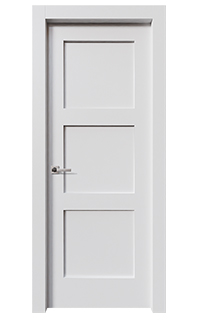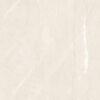Description
THE DOOR NAME ORIGIN – “SHAKER STYLE 3 EQ PANEL”
As it is with all interior doors in the Shaker Style category, this one is a no-frills interior door model designed in keeping with the Shaker cannon.
The Shakers’ furniture, as historians assure us, was made thoughtfully, with functional form and proportion. Rather than using ornamentation (such as inlays, carvings, metal pulls, or veneers, which was seen as bluntly arrogant or needlessly deceitful), creative solutions were developed, such as “asymmetrical drawer arrangements and multipurpose forms to add visual interest.”
And so forth. Apart from the style’s pointed – and occasionally elegant – simplicity, it is worth noting that eschewing inlays, carvings, and so forth can significantly reduce costs.
And so it is with this interior door model. Don’t get me wrong. This interior door is just as dependable as all other Almes doors, and easy on the eyes, which is to say that its quality is not affected by the lower price. Not at all.
And, because it is part of the Hi-Dur category … Well, about that.
Thanks to the amazing technological breakthroughs of the recent years, the “wrap” finish is, in fact, superior in some aspects to the traditional finishing methods. The process works on molecular level, essentially fusing the materials together through heat and pressure. This makes the interior door warp-proof, which is highly important where places with high humidity (especially in coastal areas) are concerned. It also makes it fade-proof, which is to say that this interior door will continue to look brand-new year after year. Scratch-resistant? Of course.
Let’s not forget the awesome hardware that comes with all our interior doors, including the Italian-made 3D-adjustable self-lubricating concealed hinges. The adjustability guarantees quick and easy installation. The self-lubrication guarantees that the door will never creak. Concealed means just that: when the door is closed, you won’t see the pin from either side. In fact, there is no pin.
There is also the soundless and highly reliable magnetic lock and, of course, the automatic sweep activated when the door is shut – this raises the door’s sound-proofing and thermal insulation qualities to levels well above the industry’s standard. The former ensure privacy; the latter will work miracles with your electrical bill.
As for the three panels of equal size:
The number 3 is the first odd prime number that has been an inspiration to humanity throughout history.
Earth is the third planet from the Sun. There are three types of galaxies: elliptical, spiral, and irregular. Orion’s belt is made up of 3 stars in a row.
The information in DNA and RNA is stored and transmitted in the form of a triplet codon system.
Humans perceive the universe to have three spatial dimensions, i.e. the length, width, and depth.
Three Roman gods, Jupiter, Neptune, and Pluto represented, respectively, air, water, and earth.
The three Roman Graces were Aglaia, Euphrosyne, and Thalia.
Three is the number of novels or films in a trilogy, as well as the number of interconnected works of art in a triptych.
The three great values espoused by the French Revolution were liberty, equality, and fraternity.
FINISH: PRIMED
The advantages of this approach – of this type of interior door finish – are fairly obvious. Pick a color, any color that suits your projects best. Mix and apply. Re- coat whenever you feel it is necessary to do so. Touch it up. It gives you, the proud owner of these interior doors, complete freedom of choice, and the significant savings, especially where it comes to bulk orders, can be a true source of joy.
As Kurt Vonnegut mentions in one of his novels (Bluebeard, unless I’m mistaken … check it out when you get a chance), the thrill of laying on colors is a large part of the artist’s professional satisfaction. In other words, a keen pleasure.
When back in the remote past visual arts became a field dominated by professionals rather than hobbyists, the main problem of “just laying on paint” became obvious: you can’t.
The medium of choice back then was egg tempera, a permanent, fast-drying substance consisting of colored pigments mixed with a water-soluble binder medium, usually glutinous material such as egg yolk. Portraits and ornaments were executed in this medium, and the wood panel was the surface of choice. One of tempera’s interesting features is that it is not as easily absorbed by wood as other mediums. Some sort of primer was necessary, of course, but pretty much any substance that dried evenly could be used.
The drawbacks of tempera, or pintura al temple, as the Spanish call it, only became obvious with the advent of the Renaissance, when the leading representatives of the trade turned to oil (and interior doors suddenly became a great deal less crude, but that’s a story for another day).
Oil painting is the process of “painting with pigments with a medium of drying oil as the binder.” Commonly used types include linseed (highly preferable in art, though not necessarily in interior doors, mind you), poppy seed, walnut, and safflower.
Today, five hundred years later, it is safe to say that oil is more versatile than pintura al temple – by orders of magnitude. Specifically, the contrasts achieved through the former are much greater, the darks are far deeper, and three- dimensional, highly realistic images are much easier to achieve. Next time you visit a museum, take a closer look at pintura al temple portraits. All of them, without exception, come off as a bit “flat” as opposed to their latter-day counterparts.
Also, where glazing is concerned …
Glazing: a painting technique in which a transparent layer, with just a touch of pigment, is laid over a previously painted surface, allowing light to travel through the glaze and be reflected back off of the opaque layer below. Gentle shadows, subtle changes of color, smooth transitions – all these can be achieved through glazing, which was used by all artists up until the middle of the Nineteenth Century, when artist tubes were invented, revolutionizing the field, and other techniques began to be explored.
Tempera enthusiasts (it takes all kinds to make a world) will assure you that glazing is not just possible in pintura al temple but is actually the basis of the whole enterprise. Well, what are you going to do? They’re enthusiasts.
Anyway, la peinture à l’huile, as the French call it, re-introduced the ancient problem of most surface’s propensity to absorb dipingere, as the Italians call the stuff. Wood or canvas, it is all the same: you’re not going to get very far without a good primer.
Experiments were conducted, and soon rabbit skin glue emerged as the least expensive and most effective solution. It was easy to apply. It dried evenly. It made the application of the l’huile stuff on top of it a walk in the park.
There were drawbacks. Today, rabbit skin glue is considered to be a major cause of cracking by most modern conservators. (Remember, when you visited the Metropolitan Museum of Art – and did you see those interior doors? … some of them are quite something … – most “old masters” pictures are completely covered with a cobweb of cracks? There you go). Because the glue is hygroscopic, it continually absorbs moisture from the atmosphere, causing the glue to swell and shrink as ambient humidity levels change. Over many humidity cycles, this repeated flexing causes the brittle oily layers to crack.
To combat this problem, modern primers are made of acrylic materials which are guaranteed not to cause any damage to the dipingere. No bubbling, no cracks. Your interior doors are safe.









